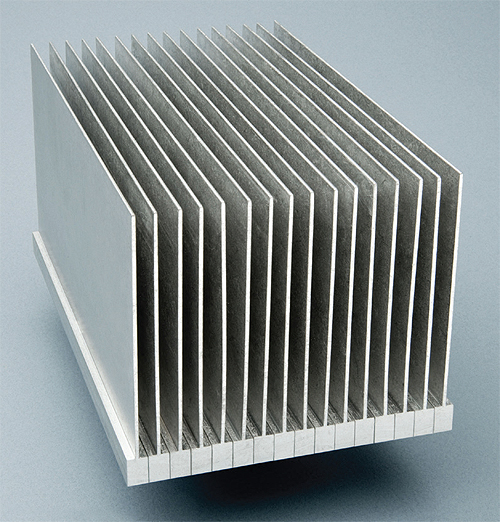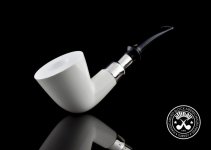I don't know the physics, but it seems logical that a thicker wall would insulate better. Do you want a handkerchief or a thick pot holder to take a pan out of the oven? However, I am intrigued that some thinner walled pipes have to be smoked by handling the shank rather than the bowl because of heat, whereas other pipes with similarly thin-walled bowls never get too hot to handle by the bowl. That must be the quality of the briar. I have a Kaywoodie with a thin wall bowl that never gets too hot to handle and other brands as well.
What Are The Physics Of "Thick Wall = Cool Smoke"?
- Thread starter Road To Pines
- Start date
You are using an out of date browser. It may not display this or other websites correctly.
You should upgrade or use an alternative browser.
You should upgrade or use an alternative browser.
SmokingPipes.com Updates
Watch for Updates Twice a Week
- Status
- Not open for further replies.
Someone on here actually measured the temperature of tobacco as it burns in the pipe and provided a detailed thermodynamics overview related to his hypothesis. That's how deep this rabbit hole goes ?
SMH! This is all so silly! I have smoked countless pipes over the years. Thick, thin, long shank, short shank, angel hail straight grain, cross grain slathered with birds eye, etc. I have NEVER detected a " cooler" smoke based on ANY of the above. Why do people insist on making pile smoking complicated??? Stuff, light, smoke, and enjoy! Sheesh!
Q/t = kAdT/d where: Q = heat transferred, t = time, k = thermal conductivity constant for briar wood, A = cross-section of the area conducting thermal energy, dT = difference in temp between the inner bowl and outer bowl wall, d = thickness of the wall. So Q/t is the amount of heat transferred per unit time.
I know. I have thick walled pipes and thin walled pipes and while every pipe smokes differently the only one I have thought yup this cools down a smoke is the falcon.SMH! This is all so silly! I have smoked countless pipes over the years. Thick, thin, long shank, short shank, angel hail straight grain, cross grain slathered with birds eye, etc. I have NEVER detected a " cooler" smoke based on ANY of the above. Why do people insist on making pile smoking complicated??? Stuff, light, smoke, and enjoy! Sheesh!
It's negligible. Even with rusticated pipes, the heat transfer to the environment is negligible. Some have argued that rusticated pipes are similar to heat sinks or radiators and have more surface area and thus smoke cooler, but not really; you'd have to have something like thisSo, to be clear, I haven't noticed this phenomenon yet. Although I have rather curious mind.
Here's what I came up with: thicker walled, larger bowls have more surface area AND thermal mass. Both of which are insanely important when taking about heat dissipation. While the big pipes may hold heat better, my theory is that the surface area allows them to get rid of that heat quicker. More contact with the air=cooler pipe.
Just a thought from a computer nerd that messes around with liquid cooling! ?

for the cooling to be noticeable, let alone efficient.
I stumbled across these eight pages of speculation regarding briar grain and speculation on heat of smoke and pipes when researching a problem with a pipe.
I am surprised fire experts didn't chime in unless I missed it.
Does wood grain effect the temperature of the pipe smoke ? Probably not discernible enough for the average person.
Does wood grain effect the temperature of the pipe for holding purposes ? There are plenty of scientific studies online regarding wood grain and the transfer of heat done when houses started to be built of wood rather than brick. Vertical grain transfers heat and flame fastest; Horizontal and slanted grain slower but it burns quicker until it reaching a charring point then its about the same. Wood thickness and density both play a part in the transfer of heat. Thicker wood walls transfer less heat; denser vertical grain more heat. For houses horizontal grain is best to slow the spread of fire if I read the study correctly.
Why does all this matter ? It probably doesn't to most but I have a beautiful pipe with a triangle of dense vertical grain that gets hotter than the rest of the pipe, because dense vertical grain transfers heat the most, so much so that the varnish bubbled and peeled off in that area so I will probably have to put a heavier chamber coating on that section of chamber. It gets so hot I literally can't touch that section of the pipe. Flame grain would be preferred to dense vertical grain for pipe heat transfer, horizontal even better.
How about the smoke ... any difference ? None, I can discern as long as I can hold the pipe !
If I get a burn out it will occur on that section of the pipe unless I address it now. Dry tobacco, slower puffing help but not in that one section.
Yes, I realize this thread had been non-active for over a year and a half but its not closed yet (maybe it will be now) and I was interested in the subject. Hope all is well and no one gets hot under the collar because I decided to comment. Happy week to all !
I am surprised fire experts didn't chime in unless I missed it.
Does wood grain effect the temperature of the pipe smoke ? Probably not discernible enough for the average person.
Does wood grain effect the temperature of the pipe for holding purposes ? There are plenty of scientific studies online regarding wood grain and the transfer of heat done when houses started to be built of wood rather than brick. Vertical grain transfers heat and flame fastest; Horizontal and slanted grain slower but it burns quicker until it reaching a charring point then its about the same. Wood thickness and density both play a part in the transfer of heat. Thicker wood walls transfer less heat; denser vertical grain more heat. For houses horizontal grain is best to slow the spread of fire if I read the study correctly.
Why does all this matter ? It probably doesn't to most but I have a beautiful pipe with a triangle of dense vertical grain that gets hotter than the rest of the pipe, because dense vertical grain transfers heat the most, so much so that the varnish bubbled and peeled off in that area so I will probably have to put a heavier chamber coating on that section of chamber. It gets so hot I literally can't touch that section of the pipe. Flame grain would be preferred to dense vertical grain for pipe heat transfer, horizontal even better.
How about the smoke ... any difference ? None, I can discern as long as I can hold the pipe !
If I get a burn out it will occur on that section of the pipe unless I address it now. Dry tobacco, slower puffing help but not in that one section.
Yes, I realize this thread had been non-active for over a year and a half but its not closed yet (maybe it will be now) and I was interested in the subject. Hope all is well and no one gets hot under the collar because I decided to comment. Happy week to all !
I tend to think thicker walls smoke cooler, but I’m not sure science backs me up.I agree with this. The thickness of the bowl will "feel" cooler but not necessarily smoke cooler.
There is also the theory of what the bowl is coated in effecting the temperature of the wood itself as well as the smoke. For example a heavily shellacked bowl would not disperse heat trapping it inside, as opposed to a waxed bowl. Which could make the wood feel hot no matter the thickness.
So Cosmic may be correct also, it's magic!
BTW, good to see you again!
Whoops! Fooled by an old thread once again!I tend to think thicker walls smoke cooler, but I’m not sure science backs me up.
BTW, good to see you again!
That's any pipe.Mostly in the smoker's control.
If the walls are thicker and a smaller ember you are saying the load capacity of the bowl is less, less bowl capacity means less space and less space for tobacco which means less "ash insulation".I'm making this up as I write, but I have a hypothesis:
Thick walls allow a smaller ember. Perhaps if the ember is more insulated then it doesn't lose heat, therefore doesn't have to be as big, and can be smoked cooler. Mostly in the smoker's control.
As well as the combustion temperature of the tobacco doesn't change.If the walls are thicker and a smaller ember you are saying the load capacity of the bowl is less, less bowl capacity means less space and less space for tobacco which means less "ash insulation".
When building a regular fire (not in a pipe). Protection is required based on the size of the fire.
Small fires need more protection than bonfires, even though combustion happens at the same temp.
Just scaling the idea down to am ember in a pipe, possibly being affected (made more stable) by insulation provided by thicker walls.
The difference is probably not noticeable, but might be.
I'm sure it could be proven that you need a larger ember (more airflow) if you want to keep a pipe lit with an aluminum bowl in cold weather. Meaning you'd have to smoke hotter to keep it going, meaning it would be more difficult to keep the smoke cool.
Again, just a personal hypothesis and possibly negligable, but a reasonable over-analyzed possibility.
Small fires need more protection than bonfires, even though combustion happens at the same temp.
Just scaling the idea down to am ember in a pipe, possibly being affected (made more stable) by insulation provided by thicker walls.
The difference is probably not noticeable, but might be.
I'm sure it could be proven that you need a larger ember (more airflow) if you want to keep a pipe lit with an aluminum bowl in cold weather. Meaning you'd have to smoke hotter to keep it going, meaning it would be more difficult to keep the smoke cool.
Again, just a personal hypothesis and possibly negligable, but a reasonable over-analyzed possibility.
I'm smoking this one right now, and I can confirm it's magic.More and more I think about it, it's not physic. It's magic!
(@timt
 )
)

Pretty much tripe. But as the pipe will be cooler in the hand, it may give the impression that the smoke itself is cooler.I've recently read in a number of posts the adage that a thick-walled pipe "smokes cooler." Can someone explain the rationale here? I'll explain my thinking below, and welcome any corrections. << Snipped bits out >>
The temperature of the ember and hence the smoke can vary a bit, but not due to the size of the walls.
Well well, aren't you quite the cyberbully....... damned social media.I'm smoking this one right now, and I can confirm it's magic.
(@timt)
View attachment 166049
View attachment 166050
That has to be the nicest pipe I've ever had in my cart.
The briar in our pipes has about twice the kindling point of other hardwoods.
And of the wood of the heath shrub only burls on the roots can be fashioned into pipes. When dug up they are wet, meaning they had capillaries, and the burls must be soaked in water to remove tannins, then dried, and ideally aged.
Then during break in, for the first dozen or two bowls the pipe will smoke hot, and there will be a burning briar taste. Lee figured out how to make this briar taste sweet, but it still requires break in.
Some things are magic, and briar is one example.
The more briar surrounding the ember the cooler the ember will burn.
Why is hard to understand, as are most things magical.
And of the wood of the heath shrub only burls on the roots can be fashioned into pipes. When dug up they are wet, meaning they had capillaries, and the burls must be soaked in water to remove tannins, then dried, and ideally aged.
Then during break in, for the first dozen or two bowls the pipe will smoke hot, and there will be a burning briar taste. Lee figured out how to make this briar taste sweet, but it still requires break in.
Some things are magic, and briar is one example.
The more briar surrounding the ember the cooler the ember will burn.
Why is hard to understand, as are most things magical.
- Status
- Not open for further replies.







